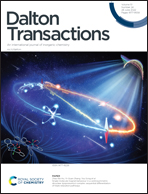High temperature spin crossover behaviour of mononuclear bis-(thiocyanato)iron(ii) complexes with judiciously designed bidentate N-donor Schiff bases with varying substituents†
Abstract
We present herein a family of molecular cis-[FeII(X-PPMA)2(NCS)2]·H2O [4-X-N-(phenyl(pyridin-2-yl)methylene)aniline; X-PPMA; X = –Cl (1), –Br (2), and –CH3 (3)] complexes that exhibit spin crossover behaviour above room temperature. Judiciously designed bidentate N-donor Schiff bases of 2-benzoylpyridine and para-substituted anilines in combination with Fe(NCS)2 were used for the synthesis of complexes 1–3. The relatively strong ligand field of the Schiff bases stabilises the low spin state of iron(II) up to 300 K which is evident from magnetic measurements, room temperature Mössbauer spectra and crystallographic bond/angle distortion parameters. Interestingly, complexes 1–3 crystallize in a tetragonal system with either a P43212 or P41212 chiral space group from achiral building units due to the supramolecular helical arrangements of molecules through intermolecular (pyridine)C–H⋯C(NCS) interactions in the crystalline state. Complexes 1 and 2 exhibit complete, gradual and slightly irreversible spin crossover behaviour in the temperature range of 300–500 K with equilibrium temperatures (T1/2) 375 K (1) and 380 K (2). The spin state evolution of iron(II) in complexes 1 and 2 is monitored between 150 K and 450 K through variable temperature crystallographic studies in the warming mode. The structural data are in good agreement with the 94% (1) and 87% (2) high spin conversion of iron(II) at 450 K. At a high temperature (450 K), some minor irreversible ligand motion is noticed in complexes 1 and 2, in addition to a complete solvent loss that may induce the slight irreversibility of the spin crossover. On the other hand, complex 3 shows a complete and gradual spin crossover in the temperature range of 10–475 K with strong irreversible features. The equilibrium temperatures obtained upon first warming (T1/2↑) and second cooling (T1/2↓) are 375 K and 200 K, respectively. In complex 3, the loss of a water molecule triggers strong deviations in the spin crossover behaviour. Moreover, dehydrated complex 3 exhibits photoswitching LIESST effect with a relaxation temperature T(LIESST) = 60 K.



 Please wait while we load your content...
Please wait while we load your content...